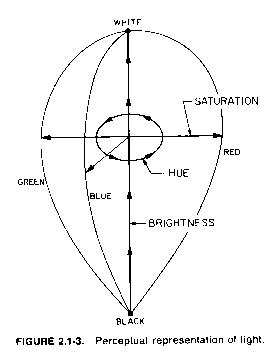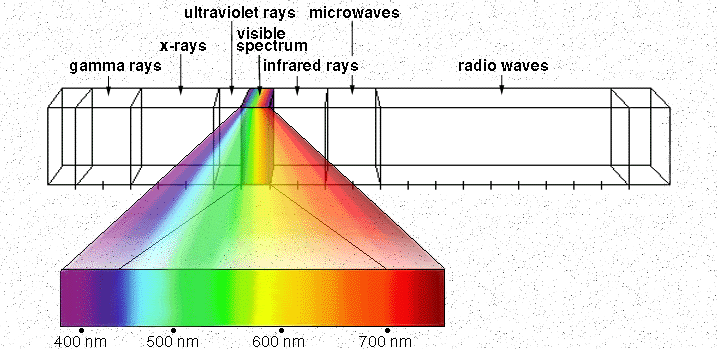Color Fundamentals and the HVS
- spectral reflectance of scene surfaces
- spectral content of ambient illumination
- spectral response of sensor
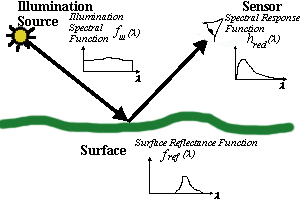
Note that we can measure how much red, green and blue we have at a point
through the following formulas:
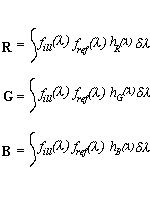
Recall from our discussion of the human visual system, camera's commonly
measure R,G,B like our three kinds of cones in our eyes. The spectral
responses of the camera is made to mimic the three spectral responses of our
three kinds of cones which roughly measure how much red, green and blue is
present.
Light Perception
Light, according to Webster's dictionary is: "radiant energy which, by its action on the organs of vision, enables them to perform their function of sight."
Light is electromagnetic radiation lying in electromagnetic spectrum over a wavelength band of 350 to 780 nm.
Not much is understood about the mechanisms by which light interacts with the "organs of vision."
A physical light source may be characterized by the rate of radiant engergy (radiant intensity) it emits at a particular spectral wavelength.
Example
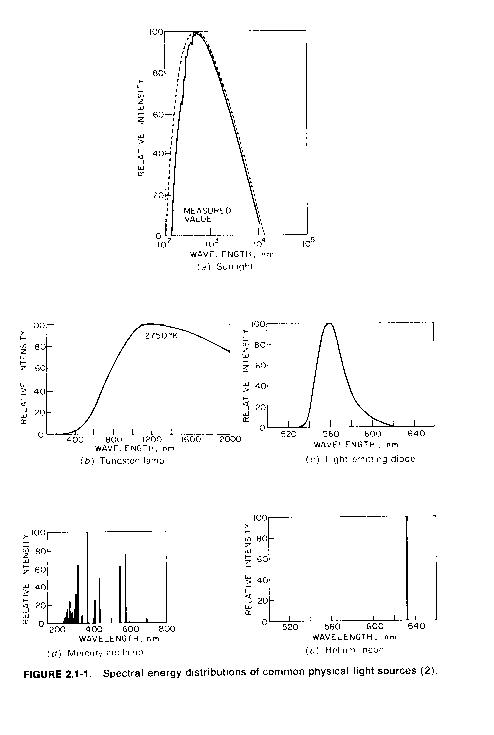
The plots above show the spectral energy distribution for (a)
sunlight, (b) a tungsten lamp, (c) a light-emitting diode, (d) a mercury arc
lamp, and (e) a helium-neon laser.
- Sunlight appears as an extremely bright yellowish-white light
- A tungsten light bulb appears less bright and somewhat yellowish
- A LED appears dim green
- A mercury arc light is a highly bright bluish-white light
- A laser produces an extremely bright and pure red beam.
Observed
light spectral engergy distribution depends on the transmissivity and
reflectivity of an object.
The Three Common perceptual descriptors of light sensation
- Hue - What is usually referred to as color in lay terms. Determined by dominant wavelengths in the spectral distribution of the light. Hue is the attribute of light that distiguishes a red colored light from a green light or a yellow light.
- Saturation - Measures the amount of white in a color. To say a color is saturated means that is has no white in it and only has spectral components necessary for producing the sensation of that hue. Recall: white is represented by a distribution with equal components at all wavelengths. A pure hue is un saturated by adding a broad spectrum distribution to its own distribution....this is how you take a pure deep red to a lighter red and then to pink. Hence, saturation is the attribute that distinguishes a spectral light from a pastel light of the same hue. In effect, saturation describes the "whiteness" of a light source.
- Intensity - Measure of energy packed into the spectral distribution of the light. You can think of it as a scale fact that is applied to the entire spectral distribution (is related to the area under the spectral distribution curve). If two light sources with the same spectral shape are observed, the source of greater physical intensity will generally appear to be perceptually brighter.
Definitions/Terms:
- Spectrcal Hue = a single wavelength in the visible spectrum. For
example, 480nm = blue, 550nm = green, 700nm=red.
- Nonspectral Hue = a mixture of wavelengths. For example, purple
is red + blue.
- Primary colors = primitive colors such as red,green, blue which
are used in an additive way to form other colors.
- Color Matching Function = a plot that tells you for each
wavelength, lambda, how much R, G, B light must be mixed to generate the
spectrally pure color represented by lambda.
- A prism and slit can produce narrowband wavelength light of varying
color.
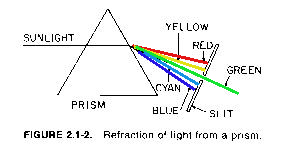 |
 |
- A single light wavelength is not adequate to measure color because some colored lights encountered in nature are not contained in the rainbow of light produced by a prisim.....they are in fact combinations of wavelengths:
- Purple light is not present in the rainbow. Purple light can be
produced by combining equal amounts of read and blue narrowband lights.
- When considering the perception of color, wavelength measurements are not unique because it is possible to have two light sources with different spectral energy distributions that are perceived identically. Such lights are called metameric pairs.
Classifying colors
As an aid to classify colors, it is
convenient to regard colors as being points in some color solid.
